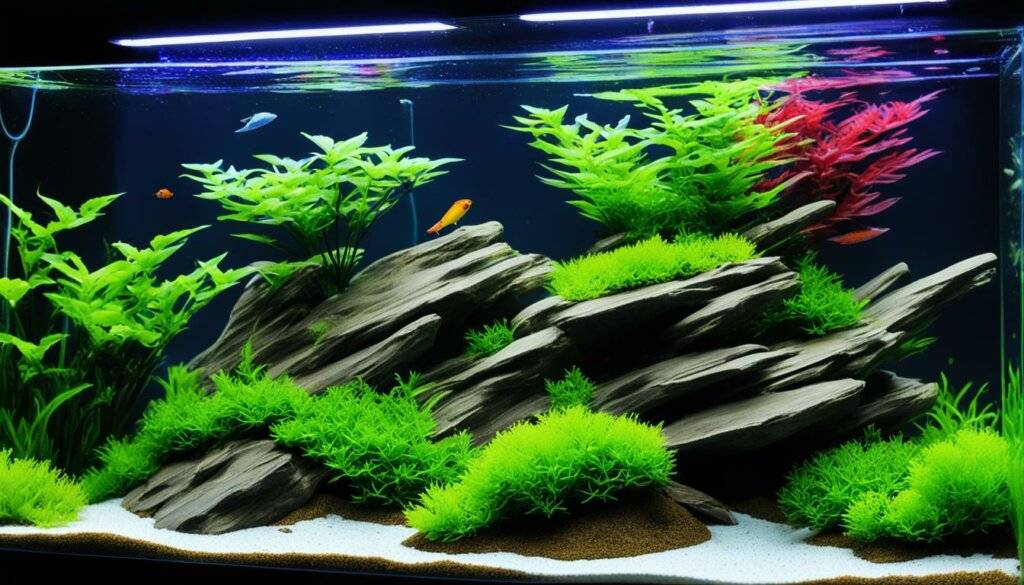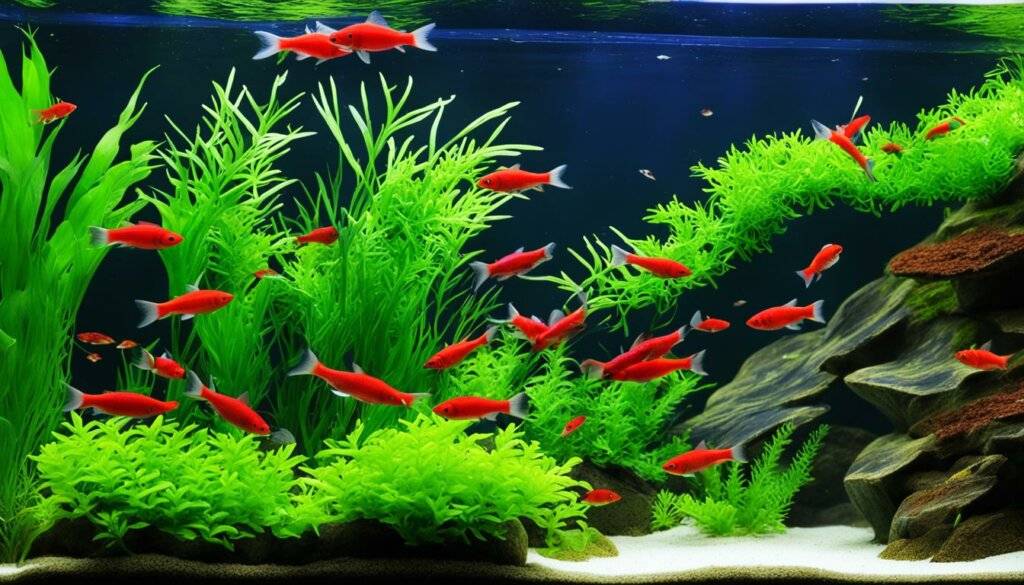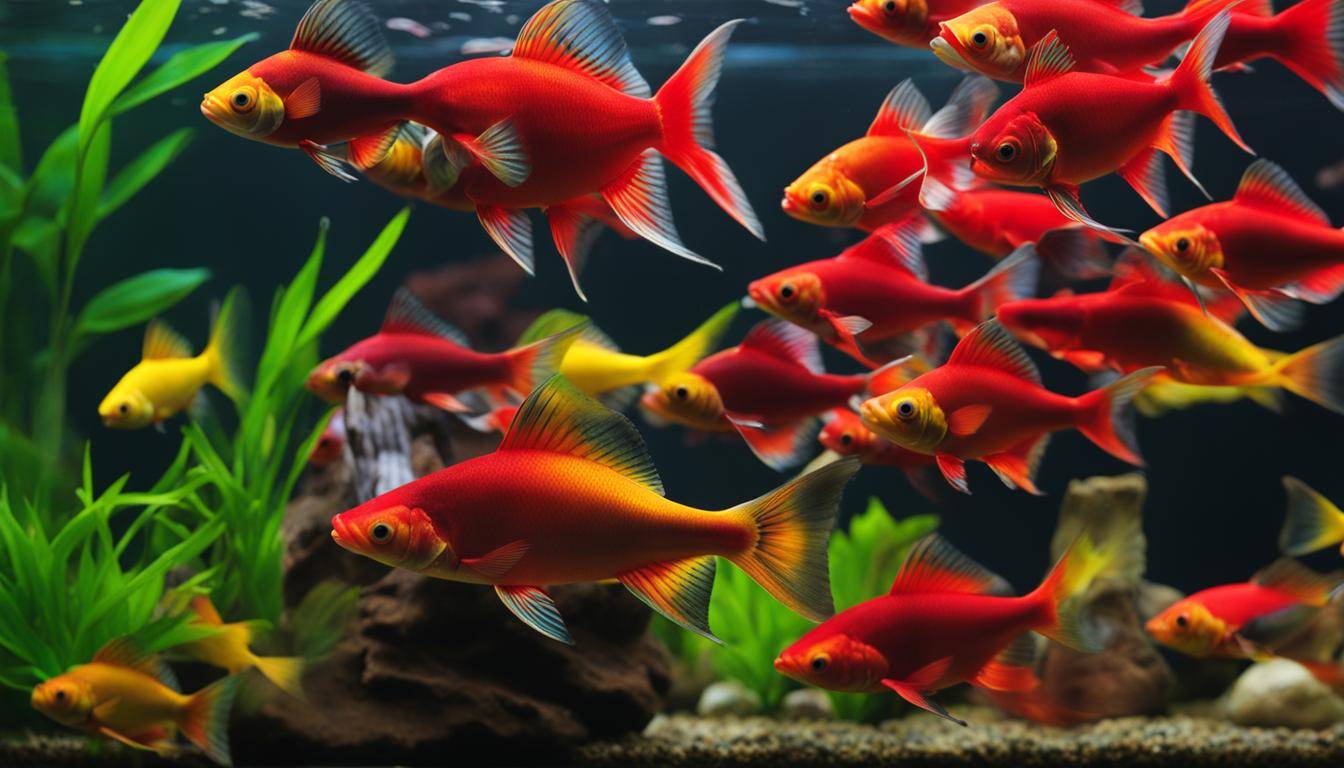Imagine entering a room filled with vibrant colors, like a live painter’s palette. You see beautiful fish gliding in a big, well-tended aquarium. The cherry barb stands out with its bright red color and lively swim.
The cherry barb, or Puntius titteya, is loved by those who adore colorful tanks. Originally from the waters of Sri Lanka, these fish are both vivid and engaging. Aquarium lovers find them irresistible.
Cherry barbs, with their slender forms and detailed colors, bring aquariums to life. The males turn bright red in the breeding season, which gives them the name “cherry” barbs. They are small, only growing up to 2 inches, but they are active and joyful. They make any tank more dynamic.
The cherry barb is a superb option whether you’re new to aquariums or experienced. They are not only stunning but also easy to look after. They prefer the top to middle of the tank. There, you can enjoy their vivid hues and graceful movements.
Let’s explore the world of cherry barbs further. We’ll look at what they need in a tank, how to feed them, how they breed, and more. Together, we’ll discover how to keep these beautiful and lively fish content in your aquarium.
Characteristics and Appearance of Cherry Barb Fish
Cherry Barbs are known for their bright colors and unique look. They are small and shaped like a torpedo. This makes them look graceful in your tank. They move smoothly through the water, which is beautiful to watch.
One standout thing about cherry barbs is their color. They shine in colors like orange and red, like a sunset. They have rich brown patterns on their bodies, and a dark stripe by their sides. This pattern makes them look even more vibrant.
In the mating season, male Cherry Barbs stand out. They turn bright red, showing their health and mating ability. Females, bigger and more rounded, look like a bronze color.
These fish grow up to 2 inches, perfect for small tanks. Their small size means they move elegantly in the water. They add beauty to any tank.
Cherry Barbs have pretty red fins. These fins make their movements sleek and beautiful. They add elegance to the fish.
What makes Cherry Barbs special is their black stripe along the body. This stripe makes them look sophisticated. They also have a hint of pink on their cheeks, a charming detail.
Tank Requirements and Compatibility of Cherry Barbs
It’s key to set up the right tank for your Cherry Barbs. They need a lot of plants, places to hide, and space to swim. A 30-gallon tank is the smallest size you should use for them.
Cherry Barbs like to be around other fish. Groups of 5-6 will help them feel safe and act naturally.
Think carefully when picking other fish to live with your Cherry Barbs. Fish like Rosy Barbs and Tetras are good choices because they have similar needs and behaviors. They will get along well.
Your Cherry Barbs can also live with calm fish in a community tank. But, all the fish in the tank need the same water. Keep out any fish that could bully or hurt your Cherry Barbs.
When you get new fish, put the Cherry Barbs in first. This lets them find their spots and feel at home. Then you can add the others.

-
Save
Suitable Tankmates for Cherry Barbs
| Tankmates | Compatibility |
|---|---|
| Rosy Barb | Compatible with Cherry Barbs |
| Black Ruby Barb | Compatible with Cherry Barbs |
| Neon Tetra | Compatible with Cherry Barbs |
| Buenos Aires Tetra | Compatible with Cherry Barbs |
With the right tank setup and friends, your Cherry Barbs will be happy. They’ll show off their bright colors and enjoy living in peace with other fish.
Care and Feeding of Cherry Barbs
Caring for Cherry Barbs is key to their health and happiness. Make sure they eat right and live in the best water conditions. This will help them do well in your fish tank.
Care:
Taking good care of your Cherry Barbs means doing regular tasks. If you have plants, keep them clean by removing dead parts. Check the pH of the water to make sure it stays steady for your fish.
Feeding:
Cherry Barbs eat both plants and meat. Give them a mix of tropical pellets, some veggies, and a few frozen snacks. This mix is vital for their health.
Water Parameters:
Cherry Barbs like a specific kind of water. It should be slightly acidic and have plenty of plants. Use a good water test kit to watch the water’s quality. This is very important for your fish.
Maintenance:
Keeping the tank clean is crucial for Cherry Barbs. Change the water often to keep it fresh and get rid of waste. A good filter also helps in keeping the environment healthy for them.
Adding places for your Cherry Barbs to hide is a great idea. You can use rocks, caves, or lots of plants for this. Hiding spots make your fish feel safe and lowers stress.

-
Save
With proper care and a good diet, your Cherry Barbs will live long and be vibrant. These lovely fish will add beauty and energy to your tank with the right care.
Breeding Cherry Barbs
Cherry Barbs are great for new fish breeders. They’re easy to breed. It’s key to set up the right home for them to have babies.
To get them to breed, the water needs to be a bit warmer. Set the heater to 79°F (26°C). You also need to give them plenty of food. This helps them get ready to make babies.
The female Cherry Barb will lay eggs on plants in the tank. These plants need to be kept safe. Otherwise, other fish might eat the eggs. Use a separate tank to protect the egg-laden plants.
After about five days, the eggs hatch. Now, the baby fish can swim around. It’s crucial to feed them right. Use special fry food or tiny creatures like micro worms.
Breeding Cherry Barbs is both thrilling and fulfilling. With the correct setup and attention, you can see new life bloom in your aquarium. This includes everything from the egg-laying to the hatching.
Common Health Issues and Diseases of Cherry Barbs
Cherry Barbs are usually pretty tough fish. But, they can still get sick with common diseases. It’s key for fish keepers to know these issues. They should act early to stop or treat them.
Fin rot
Fin rot is a top problem for Cherry Barbs. Bacteria cause this disease. It makes their fins and tails look bad, often turning them white. Things like bad water, too many fish, or stress usually start it. To stop fin rot, keep the water clean and make sure your fish are happy. If you see signs, quickly pull out the sick fish. Then, treat with meds and change the water often.
Ich (Ichthyophthirius)
Ich, or white spot disease, is also common. It’s because of a tiny parasite. This bug makes white dots on the Cherry Barbs’ body. Stress and changing water add to the risk of getting Ich. To keep your fish safe, keep the water calm, feed them well, and clean the tank diligently. Meds that target Ich can help alongside these steps.
Velvet disease (Oodinium)
Velvet disease, caused by the parasite Oodinium, is known by its yellowish spots. Fish with this illness might seem lazy, not eat, and rub against tank objects. Stress and bad tank conditions bring on velvet disease. Keep the water right, feed them well, and clean the tank as steps to avoid issues. Meds can also help, just be sure to stick to the directions on how to use them.
Conclusion
In summary, the Cherry Barb is full of life and color. They are perfect for any freshwater tank. They are ideal for beginners or experts because they are easy to take care of and very peaceful. Just make sure their tank, food, and care are right, and your Cherry Barbs will thrive.
Breeding Cherry Barbs can be thrilling. Their bright colors and how they interact make any aquarium more beautiful. With the right environment – warm water and enough food, you might see new Cherry Barbs come to life. This is quite an amazing sight.
Wrapping up, the Cherry Barb is a joy to have in your tank. They add beauty and fun with their colors and behavior. For anyone who loves fish and aquariums, Cherry Barbs are a top pick. They’ll make your tank a more lively and beautiful place.
